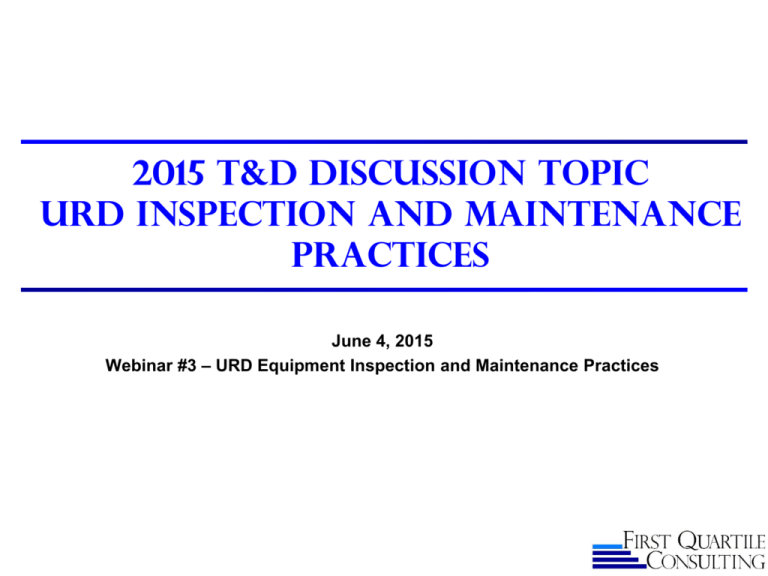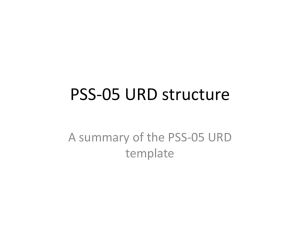URD Inspection & Maintenance Webinar #3
advertisement

2015 T&D Discussion Topic URD Inspection and Maintenance Practices June 4, 2015 Webinar #3 – URD Equipment Inspection and Maintenance Practices Discussion Topic Webinars – URD Inspection and Maintenance Practices Webinar #1 URD Standards and Maintenance Issues May 21, 2015 Webinar #2 URD Cable Management Practices May 28, 2015 Webinar #3 URD Equipment I&M Practices June 4, 2015 Issues to be discussed: • • • URD design and construction standards –current and historical Reliability trends Problematic equipment • • • • Expected company participants*: Asset Manager URD Standards Engineer Distribution Reliability Data Expert Trends in cable failure rates Cable rehabilitation policies Cable treatment programs Cable replacement programs • • Asset Manager URD Cable Mgmt Program Manager Field Supervisor/ Manager Asset Manager URD I&M Program Manager(s) Field Supervisor/ Manager • • URD primary riser I&M URD switchgear/junction box I&M URD transformer I&M URD secondary equipment I&M 2 Background ◼ URD equipment may either be installed above grade, on foundation pads, or below grade in an enclosure or vault. ◼ One concern about URD equipment, whether it is installed above or below grade, is that it is more accessible to the public than overhead equipment. This public safety concern has lead utilities to: 1. Install locking mechanisms (often dual locks) on URD equipment cabinets 2. Perform periodic external inspections to ensure that the locks are still in place and that the exterior cabinets have not been damaged or deteriorated to the point where live parts are exposed. 3. Some utilities are also now using test equipment to periodically verify that no contact voltage is present on the equipment cabinets ◼ The scope, extent and frequency of internal inspections of URD equipment vary across utilities. The primary purpose of today’s webinar is to develop a better understanding of the differences within our T&D community and what factors influenced our companies to adopt the practices that they have. ◼ We also want to learn how companies are evaluating the effectiveness of their URD equipment I&M programs from a cost versus benefit or cost versus reliability perspective 3 Webinar #3 Discussion Guide -- URD Equipment Inspection and Maintenance Practices 1. Please describe your current I&M program for URD primary risers: a. Program scope • All risers or focused on specific circuits, installation types and/or vintages? • Any specific regulatory requirements? b. Inspection cycle c. Technology used in inspection process (e.g., infrared cameras, contact voltage meters, etc.) d. Source and qualifications of inspection personnel e. Inspections targeted at what specific subcomponents and what types of defects/deterioration? (provide 1QC a copy of your I&M form or checklist, if possible) f. Maintenance tasks typically performed at time of inspection g. Follow-up maintenance/repair tasks typically scheduled based on inspection results h. Program effectiveness measures 4 Webinar #3 Discussion Guide -- URD Equipment Inspection and Maintenance Practices (Continued) 2. Please describe your current I&M program for URD switchgear and primary junction boxes: a. Program scope • All switchgear or focused on specific circuits, equipment types and/or vintages? • Any specific regulatory requirements? b. Inspection cycle c. Technology used in inspection process (e.g., infrared cameras, contact voltage meters, etc.) d. Source and qualifications of inspection personnel e. Inspections targeted at what specific subcomponents and what types of defects/deterioration? (provide 1QC a copy of your I&M form or checklist, if possible) f. Maintenance tasks typically performed at time of inspection g. Follow-up maintenance/repair tasks typically scheduled based on inspection results h. Program effectiveness measures 5 Webinar #3 Discussion Guide -- URD Equipment Inspection and Maintenance Practices (Continued) 3. Please describe your current I&M program for URD transformers: a. Program scope • All transformers or focused on specific circuits, customers equipment types and/or vintages? • Any specific regulatory requirements? b. Inspection cycle c. Technology used in inspection process (e.g., infrared cameras, contact voltage meters, etc.) d. Source and qualifications of inspection personnel e. Inspections targeted at what specific subcomponents and what types of defects/deterioration? (provide 1QC a copy of your I&M form or checklist, if possible) f. Maintenance tasks typically performed at time of inspection g. Follow-up maintenance/repair tasks typically scheduled based on inspection results h. Program effectiveness measures 6 Webinar #3 Discussion Guide -- URD Equipment Inspection and Maintenance Practices (Continued) 4. Please describe your current I&M program for URD secondary equipment (enclosures/pedestals, service wire and connections): a. Program scope • All equipment or focused on specific equipment types, applications and/or vintages? • Any specific regulatory requirements? b. Inspection cycle c. Technology used in inspection process (e.g., infrared cameras, contact voltage meters, etc.) d. Source and qualifications of inspection personnel e. Inspections targeted at what specific subcomponents and what types of defects/deterioration? (provide 1QC a copy of your I&M form or checklist, if possible) f. Maintenance tasks typically performed at time of inspection g. Follow-up maintenance/repair tasks typically scheduled based on inspection results h. Program effectiveness measures 7 Discussion Topic Deliverables ◼ Recordings and summaries of all webinar discussions ◼ Insights Conference -- 1QC presentation of webinar results and key insights learned through the discussions ◼ Insights Conference -- Company presentations with specific practice examples 1. Are there any specific topics/subtopics that we should ask companies to discuss? 2. Are there any companies that will volunteer today to make a presentation? 8 Possible Topics for Company Presentations 1. Why or how have some companies achieved successful outcomes with direct buried construction over the long term and others have not? (panel discussion) 2. What data collection and analysis tools/systems are being used to optimize and support the processes (for both cable management and equipment inspection, maintenance and replacement)? 3. How are companies scheduling and coordinating the system isolation, diagnostic testing, cable treatment, cable replacement and equipment inspection and maintenance/replacement work to maximize efficiency and minimize customer inconvenience? 4. What are the plusses and minuses of the IMCORP versus CableWISE diagnostic testing techniques, and what specific results and benefits have companies achieved through such testing? 9 Thank You for your Participation Your Team Dave Canon Dave.Canon@1qconsulting.com 817-980-7909 Debi Cook Debi.Cook@1QConsulting.com 760-272-7277 Ken Buckstaff Ken.Buckstaff@1QConsulting.com 310-922-0783 Dave Carter Dave.Carter@1qconsulting.com 414-881-8641 David Weiler David.Weiler@1qconsulting.com 607-761-6778 About 1QC First Quartile Consulting is a utility-focused consultancy providing a full range of consulting services including continuous process improvement, change management, benchmarking and more. You can count on a proven process that assesses and optimizes your resources, processes, leadership management and technology to align your business needs with your customer’s needs. Visit us at www.1stquartileconsulting.com | Follow our updates on LinkedIn Corporate Offices Satellite Offices 400 Continental Blvd. Suite 600 El Segundo, CA 90245 (310) 426-2790 New York | Maryland | Texas | Wyoming | Wisconsin 10



